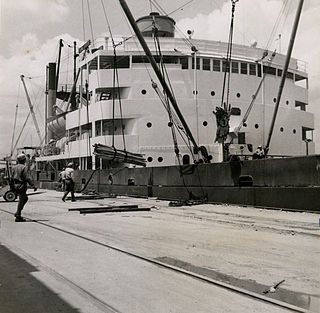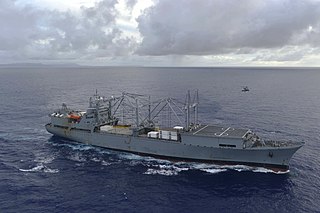
Liberty ships were a class of cargo ship built in the United States during World War II. Though British in concept, the design was adopted by the United States for its simple, low-cost construction. Mass-produced on an unprecedented scale, the Liberty ship came to symbolize U.S. wartime industrial output.

SS Mission Solano was a Type T2-SE-A2 tanker built for the United States Maritime Commission during World War II. After the war she was acquired by the United States Navy as USS Mission Solano (AO-135). Later the tanker transferred to the Military Sea Transportation Service as USNS Mission Solano (T-AO-135). A Mission Buenaventura-class oiler, she was named for Mission San Francisco Solano, she was the only U.S. Naval vessel to bear the name.
SS Midnight may refer to one of two Type C2-S-AJ1 ships built by North Carolina Shipbuilding for the United States Maritime Commission during World War II:
Or SS Topa Topa may refer to one of two Type C2-S-E1 ships built by Gulf Shipbuilding for the United States Maritime Commission:
SS Iberville may refer to one of three Type C2-S-E1 ships built by Gulf Shipbuilding for the United States Maritime Commission:

SS Jean Lafitte may refer to one of two Type C2-S-E1 ships built by Gulf Shipbuilding for the United States Maritime Commission:
SS Antinous may refer to one of two Type C2-S-E1 ships built by Gulf Shipbuilding for the United States Maritime Commission:
A number of steamships were named Afoundria, including –
SS Rainbow may refer to one of several Type C2 ships built for the United States Maritime Commission:
SS Mormacmail may refer to one of several Type C3 ships built for the United States Maritime Commission on behalf of Moore-McCormack Lines:
SS Exford may refer to one of several ships of American Export Lines:
SS Conastoga may refer to one of three Type T2 tankers built for the United States Maritime Commission during World War II:

The Type C5 ship is a United States Maritime Administration (MARAD) designation for World War II breakbulk cargo and later a container ship for containerization shipments. The first type C5-class ship was a class of ships constructed and produced in the United States during World War II. The World War II C5-class ship was dry bulk cargo ship built by Bethlehem Steel in Sparrows Point, Maryland. Bethlehem Steel built eight ships in this bulk cargo class and four orders were canceled. The C5-class ship has a 24,250 DWT and was 560 feet (170 m) long. The C5 was mainly used as iron ore carriers. The C5 was needed to replace other ships that sank during World War II. First in her class was SS Venore, USMC #1982, delivered on 20 July 1945. The Type C5-class ship designed to fill the need to move iron ore from Santa Cruz, Chile, to Sparrows Point, Maryland, through the Panama Canal, a round-trip of 8,700 nautical miles . Post World War II, four ships were given C5 class type C5-S-78a, these were roll-on/roll-off container ship built by Ingalls Shipbuilding, Inc. of Pascagoula, Mississippi and operated by the Moore-McCormack Lines. The C5-S-78a had a deadweight tonnage of 16,000 tons.
The Type L6 ship is a United States Maritime Administration (MARAD) designation for World War II as a Great Lakes dry break bulk cargo ship. The L-Type Great Lakes Dry Bulk Cargo Ships were built in 1943 to carry much-needed iron ore from the upper Great Lakes to the steel and iron production facilities on Lakes Erie and Ontario in support of the war effort. The ships have a 15,675 tonne deadweight tonnage. The L6 ships were built by two companies: American Ship Building Company, in the case of the type L6-S-A1 models, of which 6 were built; and Great Lakes Engineering Works, Ashtabula, Ohio/ Great Lakes Engineering Works, River Rouge, Ohio, in the case of the type L6-S-B1, which produced 10 ships. Steel supply needed for World War was great. To supply iron ore from Lake Superior to steel foundries, the United States Commission had a series of L6 Lakers ship built. The Maritime Commission ordered ten Great Lakes Bulk Carriers of the L6-S-B1 type. The L6-S-B1 was design with a 3-cylinder triple expansion steam engines. The L6-S-A1 used a lentz 4-cylinder compound engine. All L6 ships were coal burning and delivered between May and November 1943. L6-S-B1 was built for the US Maritime Commission under USMC contract MCc-1834 in 1943 at the River Rouge yard. Each L6 ship cost $2.265 million. The first L6-S-B1 was the SS Adirondack/Richard J. Reiss, hull 290, keel was laid on March 9, 1942 and launched on September 19, 1942. The ships are often called the Class Lake Bulk Freighter now.
SS James A. Wetmore was a Liberty ship built in the United States during World War II. She was named after James A. Wetmore, the Acting Supervising Architect of the United States, from 1915–1933.
SS Patrick H. Morrissey was a Liberty ship built in the United States during World War II. She was originally named after Patrick H. Morrissey, a former head of the Brotherhood of Railway Trainmen. She was transferred to the British Ministry of War Transportation (MoWT) and renamed Samdee upon completion.
SS William Cox was a Liberty ship built in the United States during World War II. She was named after William Cox, who was lost at sea while he was a fireman on SS David H. Atwater, that was shelled by German submarine U-552, 2 April 1942, off Virginia.
SS John Hay was a Liberty ship built in the United States during World War II. She was named after John Hay, private secretary and assistant to Abraham Lincoln, the 12th United States Assistant Secretary of State, United States Ambassador to the United Kingdom, and United States Secretary of State under Presidents William McKinley and Theodore Roosevelt.
This page is based on this
Wikipedia article Text is available under the
CC BY-SA 4.0 license; additional terms may apply.
Images, videos and audio are available under their respective licenses.



